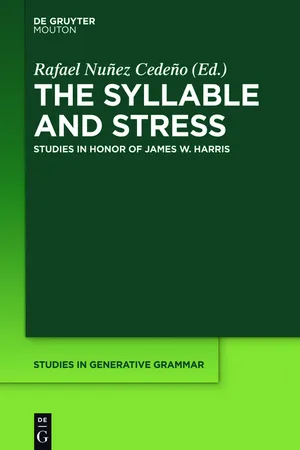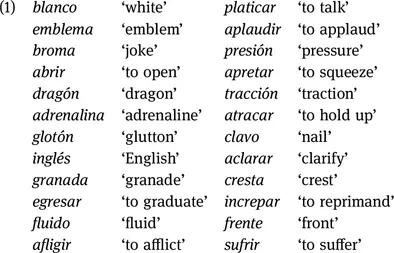
This is a test
- 358 pages
- English
- ePUB (mobile friendly)
- Available on iOS & Android
eBook - ePub
The Syllable and Stress
Book details
Book preview
Table of contents
Citations
About This Book
In this volume, notable scholars honor James W. Harris for his contributions to Romance phonology. Inscribed within generative grammar, the studies seek to explain various phonological processes, structured around glides, aspects of onsets/codas as well as stress and weight. This book will be a useful reference tool for specialists in theoretical phonology, language acquisition, language in contact, bilingualism, and Spanish dialectology.
Frequently asked questions
At the moment all of our mobile-responsive ePub books are available to download via the app. Most of our PDFs are also available to download and we're working on making the final remaining ones downloadable now. Learn more here.
Both plans give you full access to the library and all of Perlego’s features. The only differences are the price and subscription period: With the annual plan you’ll save around 30% compared to 12 months on the monthly plan.
We are an online textbook subscription service, where you can get access to an entire online library for less than the price of a single book per month. With over 1 million books across 1000+ topics, we’ve got you covered! Learn more here.
Look out for the read-aloud symbol on your next book to see if you can listen to it. The read-aloud tool reads text aloud for you, highlighting the text as it is being read. You can pause it, speed it up and slow it down. Learn more here.
Yes, you can access The Syllable and Stress by Rafael A. Núñez-Cedeño, Rafael A. Núñez-Cedeño in PDF and/or ePUB format, as well as other popular books in Filología & Lingüística. We have over one million books available in our catalogue for you to explore.
Information

II The Syllable – Onset, Coda, and Cross Linguistic Aspects
Sonia Colina
On onset clusters in Spanish: voiced obstruent underspecification and /f/
Abstract: Onset clusters in Spanish consist of an obstruent or /f/ plus a liquid, with the exception of /tl/ and /dl/ which are ill formed in some dialects (*tl) and or in all (*dl). While this descriptive generalization is uncontroversial, the phonological account of onset clusters has been a topic of debate amongst phonologists for decades now. Most agree that the main factor driving the onset generalization and the well-formedness of the cluster is sonority; yet, it is not entirely clear why /f/ is the only fricative grouped with the obstruents. This paper contributes to our understanding of onset clusters by: (i) presenting additional evidence regarding the sonority of /f/, in support of the proposal in Martínez-Gil (2001); (ii) introducing refinements to the onset cluster generalization/condition (OC) (Martínez-Gil 2001; Colina 2009), most importantly with regard to point of application. The current proposal rests on input and output underspecification of voiced obstruents.
0Introduction
Onset clusters in Spanish consist of an obstruent or /f/ plus a liquid, e.g., blanco ‘white’, egresar ‘to graduate’, sufrir ‘to suffer’, with the exception of /tl/ and /dl/ which are ill formed in some dialects (*tl) and/or in all (*dl). While this descriptive generalization is uncontroversial, the phonological account of onset clusters has been a topic of debate amongst Spanish phonologists for several decades now (Harris 1983, Harris 1989a, 1989b, Martínez-Gil 1997, Martínez-Gil 2001, Colina 2009a). Most analyses agree that the main factor driving the onset generalization and the well-formedness of the cluster is sonority. Yet, it is not entirely clear why /f/ is the only fricative grouped with the obstruents. Onset clusters cannot be fully understood without an account of the behavior of /f/ in this syllabic position. This paper contributes to our phonological understanding of onset clusters in Spanish by: (i) presenting additional independent evidence regarding the sonority of /f/ and of voiced stops in Spanish, supporting the proposal in Martínez-Gil (2001); (ii) highlighting the implications of this account for the rest of the phonology, specifically with regard to phonemic inventory and underspecification and voiced obstruent alternations (iii) introducing refinements to the onset cluster generalization/condition (OC) (Martínez-Gil 2001; Colina 2009a), most importantly with regard to the point at which the generalization applies. The proposal put forth here – which argues that voiced stops are underspecified in the input and output of the phonology – also contributes to the phonological literature on the topic of output (perseverant) underspecification.
The paper is organized as follows: the data is presented in section 1; section 2 focuses on existing attempts to account for onset cluster generalizations, including a review of the literature in Spanish and the problems to be addressed in this paper; in section 3 the account that voiced obstruents are underspecified is developed, including the data and literature on voiced obstruent alternation (3.1), the evidence, and the formal analysis (3.2). Finally, section 4 introduces the matter of the point of application of the complex cluster generalization, and how the current proposal addresses it, including some relevant Chilean data. Section 5 presents an overview of the paper and some conclusions.
1Onset clusters in Spanish: the data
Onset clusters in Spanish consist of a voiceless or voiced stop /p, t, k, b, d, ɡ/ or /f/, as the first member of the cluster, and a liquid /l, ɾ/ as the second (1). The generalization applies in word-initial position as well as word-medially.

Exceptions to the generalization include the coronals /t, d/. /dl/ is always ill formed and /tl/ is acceptable only in some varieties, mostly under the influence of languages that have this sequence, like Nahuatl (2b).82 In those Spanish varieties in which /tl/ is not a well-formed cluster, the obstruent is syllabified in the coda and the liquid in the following onset, as seen in (2a).
(2)Syllabification of the cluster -tl-

Harris (1983:33) attributes these facts to co-occurrence restrictions on two adjacent coronals, and on voice in the case of /dl/. Accordingly, he proposes the filter in (3a), which states that a consonant cluster consisting of two non-continuant, coronal consonants that also agree in voice is not permissible. Varieties in which */tl/ is ill formed have a more restrictive filter that rules out a sequence of two [-continuant] and [+coronal] segments in the onset, irrespective of their voice specification (3b).

Restrictions on /tl/ and /dl/ in onset clusters are not specific to Spanish and are frequent in many languages (Parker 2012: 151). More recently, phonetic evidence has shown that these clusters present issues of perceptibility, in particular it is difficult to discriminate auditorily between /tl/ /dl/, on the one hand, and /kl/ /ɡl/, on the other (Flemming 2002, 2007). The explanation is that the articulatory gestures of the liquid can obscure stop formant transitions if they overlap with the stop (formant transitions, along with stop burst, are crucial cues for stop place). Additional support for this view comes from Blevins and Grawunder (2009) who point to historical changes in Germanic and other languages involving *kl > tl and vice versa that are motivated by the difficulty involved in the perception of the contrast.
2Accounting for Spanish onset clusters
In order to offer an account of Spanish onset clusters and to formulate a generalization that goes beyond description (cf. section 1), the concept of sonority must be introduced. Existing analyses of Spanish onset clusters attribute the main factor driving the well-formedness of the clusters to sonority.
2.1Onset clusters and sonority
Sonority has no straightforward phonetic definition. It has been traditionally associated with perceptual salience in terms of acoustics and with degree of stricture in articulatory terms. However, recent phonetic studies indicate that intensity (i.e., loudness) is probably the most robust correlate of sonority in measurable phonetic terms (Parker 2008, 2012; Henke, Kaisse and Wright 2012), although it is unlikely to be the only one.83
In phonological terms, sonority can be considered “a unique type of relative, n-ary (non-binary) feature-like phonological element that potentially categorizes all speech sounds into a hierarchical scale (Parker 2011: 1160).” Sonority is often defined in terms of its effect on syllable phonotactics. Syllables exhibit a contour according to which the syllable rises in sonority towards the nucleus (the most sonorous point) and decreases towards the coda (Sonority Sequencing Principle, SSP, Clements 1990). In addition, the rise is maximal in the onset and minimal in the coda, according to the Sonority Cycle (Clements 1990). Since sonority is a universal but relative and gradient concept, segments are ranked according to sonority in a universal scale, such as (4).
(4)Obstruents < Nasals < Liquids < Glides < Vowels
The scale is universal with regard to the relative degree of sonority of the classes, so that an obstruent will always be less sonorous than a nasal and a nasal in turn will always be less sonorous that a vowel. Languages differ, however, in the number of sonority classes needed.
While most (if not all) of the literature on Spanish onset clusters is sonority-based, it must be acknowledged that the notion of sonority and its role in syllable phonotactics is a somewhat controversial issue in phonological theory today (cf. for instance, the topic of a recent book, The sonority controversy, Parker (2012)). Not all researchers agree that syllable phonotactics are entirely ascribable to sonority. Some argue that a perception-based account captures phonotactic generalizations, including those pertinent to onset clusters, more adequately than sonority by offering wider empirical coverage (Wright, 2004; Henke, Kaisse and Wright 2012; among others); thus they propose replacing sonority scales with scales of auditory cue robustness, according to which the cross-linguistic phonotactic patterns observed in onset clusters respond to the maximization of perceptually recoverable strings. Take, for instance, /s/ + stop clusters. Despite violating sonority requirements (because of flat or decreasing sonority, depending on the scale in use), /s/ + stop clusters are a frequent sequence in the world’s languages; they are in fact the most attested pattern in some surveys (Morelli 1999, 2003). Proponents of a perception-based account of onset phonotactics contend that a sonority-bas...
Table of contents
- Cover
- Title Page
- Copyright
- Contents
- Foreword
- Tabula gratulatoria
- I The Syllable and Glides
- II The Syllable – Onset, Coda, and Cross Linguistic Aspects
- III The Syllable and the Notions of Stress and Weight
- Subject index
- Index of constraints
- Footnotes